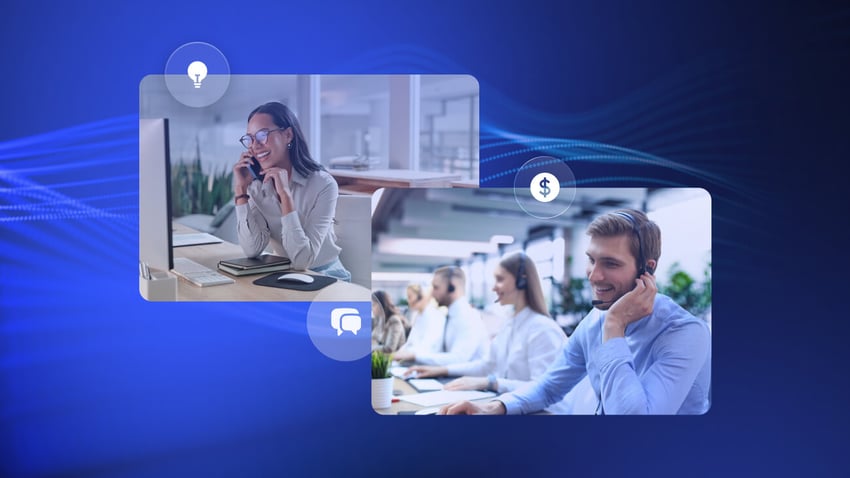Your customer service contact center is the frontline of your brand’s reputation.
When customers reach out, fuming about issues they can’t resolve on their own, your live agents must transform into resolution ninjas. We’re talking about providing personalized customer experiences across touchpoints, delivering next-level problem-solving, and securing glowing customer satisfaction (CSAT) scores.
But your agents can’t exceed your expectations with a clunky, disjointed legacy system. To succeed in the ever-demanding world of customer experience, they need an omnichannel contact center that unites customer data, text messages, emails, chatbot histories, purchases, and more.
Where Do You Rank on the AI Maturity Curve?
Take the 5-minute assessment and get a personalized score and recommended next steps.
This guide runs through all the essential features to look for when choosing a cloud contact center solution that enables your team to become champions.
From key considerations and the latest AI-powered tools to pricing and metrics, you’ll find out everything you need to launch a contact center that delights customers, agents, and even your boss.
How to Choose the Right Customer Service Contact Center
Contact center software is mission control for customer interactions. It’s the central hub where communication channels converge and your team effortlessly handles customer calls, emails, technical support, and social media inquiries.
Your contact center platform must offer these overall functionalities to ensure a smooth, efficient operation and unified customer experience.
Omnichannel support
Do you know why implementing an omnichannel strategy ranks as one of the most essential customer service goals?
Because nearly 75% of customers expect companies to understand their unique needs and expectations, and omnichannel gives your team the mind-reading power to do so.
In a multichannel system, teams monitor multiple digital channels, but that data is locked away in separate silos. Agents can’t access chatbot transcripts when a customer contacts them over the phone, forcing customers to repeat information or start over.
Omnichannel support eliminates the feeling of running into a brick wall. It unifies channels and customer data into a single dashboard for your agents. Customers can start a conversation with an inbound call center agent, seamlessly transition to live chat on your website, and then continue the conversation where they left off on social media.
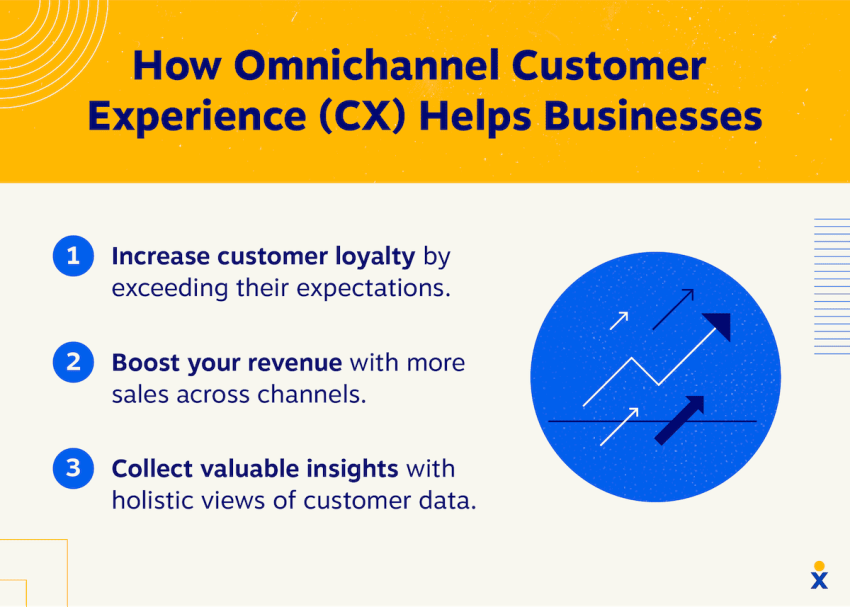
This unification empowers your team to personalize each experience to meet customers exactly where they are in their customer journey. It also translates to significantly higher customer engagement, loyalty, and retention scores. That’s why it’s the future of customer care.
Scalability
Your organization is a living, breathing entity — it grows and evolves. Your contact center technology should do the same.
A scalable contact center adapts to your brand, easily scaling up or down based on your customer volume, support needs, seasonality, and more. It should also expand alongside your team, effortlessly accommodating new work-from-home agents.
Security & compliance
Keeping customer data safe builds trust — which is important considering that almost 60% of consumers say a single data breach would negatively impact their likelihood of buying from a company again.
Your contact center software must include robust security features like data encryption and access controls. If applicable to your business, it must also comply with regulations like PCI-DSS (for credit card data) or HIPAA (for healthcare data).
Reporting & analytics
Comprehensive reporting and analytics tools give you X-ray vision, so you can always check your contact center’s performance.
The best platforms track critical metrics like call volume, agent performance, and first-contact resolution rates. They use AI to analyze and share this data via easy-to-understand reports and intuitive dashboards.
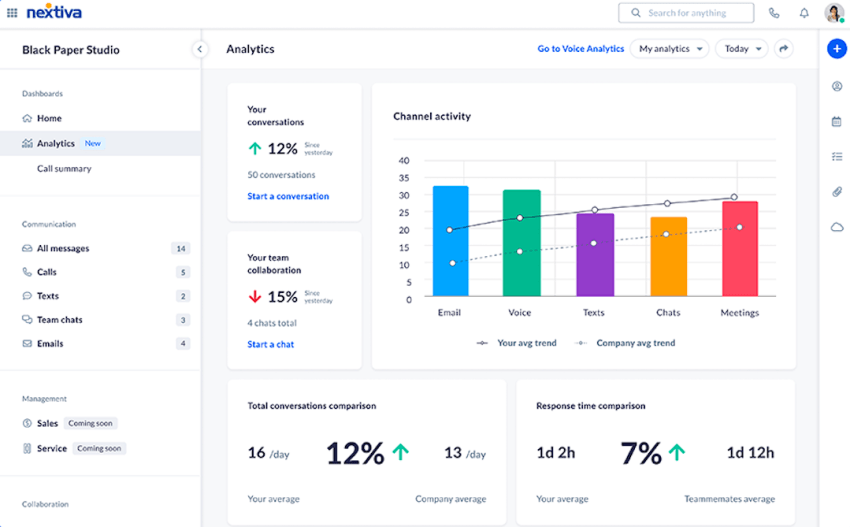
Acting on this intel allows your team to identify areas for improvement, optimize for peak efficiency, and measure success.
Ease of use
Contact center agents shouldn’t spend hours wrestling with a complex interface. Prioritize platforms that are so intuitive and user-friendly for agents and administrators that they don’t feel like work.
Clear navigation and straightforward dashboards allow agents to focus on what they do best: providing exceptional customer service. Uncomplicated systems also mean faster onboarding and training, speedier resolutions, and happier agents.
Must-Have Features for Customer Service Contact Centers
Now that we’ve covered the basics, these features will take your contact center to the next level.
Automatic call distributor
If you want to run a customer service powerhouse, automatic call distributor (ACD) is a no-brainer. This nifty feature automatically routes incoming calls to the most qualified call center agents. You can base routing on predefined criteria like skillset, availability, and even workload.
ACD guarantees customers reach the right person the first time. As a result, you’ll score higher efficiency, reduced wait times, improved first-resolution rates, and brilliant CSAT scores.
Skills-based routing
Let’s take ACD up a notch. Skills-based routing directs calls to agents with the expertise to solve specific customer issues. So, the tech whiz on your team gets the call about a software glitch while the billing expert tackles a complicated invoice issue.
This next-level routing improves resolution rates and empowers agents to leverage their skills and strengths, keeping them engaged and motivated and boosting job satisfaction.
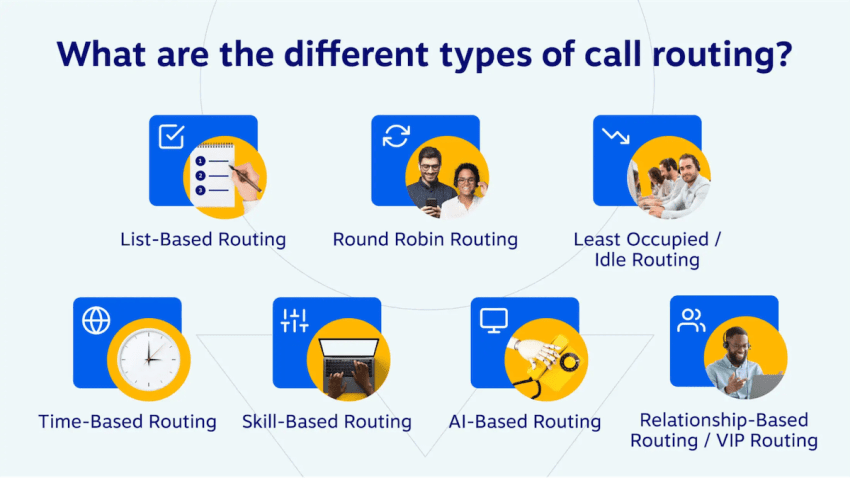
Interactive voice response
Consider interactive voice response (IVR) as your helpful robot receptionist. It allows callers to navigate self-service options using voice prompts. IVR can answer simple questions, direct callers to the correct department, or collect basic information before connecting them to an agent.

Customer service automation like this frees up your agents for more complex issues requiring a human touch while still providing a convenient experience for customers needing quick answers.
Call recording & monitoring
Call recording is like having a video replay button for your customer interactions. You can monitor calls for quality assurance, review past interactions between agents and customers for dispute resolution, and gather valuable customer feedback.
Cue the training montage! Recording calls lets you monitor agent performance and identify areas for coaching. It also allows you to grab specific use case examples for training purposes to hone customer service skills or provide new hires with real-world scenarios to practice during onboarding.
Call barging & whisper coaching
Need to jump in and assist an agent on a tricky call? Call barging allows a supervisor to seamlessly join live conversations without the customer’s knowledge or take over the call if necessary.
With whisper coaching, supervisors can provide real-time guidance and feedback through a private line, unheard by the customer.
These tactical features ensure that every customer interaction ends on a positive note. They may also speed up your agent training time. With supervisors able to provide on-the-spot support, your new hires can learn on the job and have a lifeline should they need one.
Customer relationship management integrations
Call center software that integrates with your customer relationship management (CRM) system gives agents a 360-degree view of your customer data.
They can easily, seamlessly, and readily leverage this intel to personalize customer interactions across touchpoints. They’ll also be equipped to connect the dots between each stage of your customer journey.
Integrating your CRM may be a game-changer, as research shows that access to one:
- Helps teams better understand their customers
- Allows teams to visualize customer patterns and trends
- Drives more holistic customer service experiences
- Increases conversion rates by up to 300% and revenue by as much as 245%
- Improves customer retention significantly
Related: How to Overcome These 15 Contact Center Problems
Advanced Features for Customer Service Contact Centers
Now, let’s talk about how to give your contact center the ultimate competitive edge. Add these advanced features to your wish list to create a well-oiled customer service machine.
AI chatbots
AI chatbots are your team’s tireless first responders. Harness their time-saving prowess by letting them:
- Handle routine inquiries and answer FAQs
- Troubleshoot basic problems to free up agents for complex issues
- Schedule appointments
- Direct website visitors to your self-service knowledge base or support forum
- Gather information to pre-populate forms before a customer connects with a live agent
The best part? Chatbots work around the clock, providing 24/7/365 customer support. With their assistance, you can schedule fewer live agents during nights, weekends, and holidays without disappointing your off-hours customers.
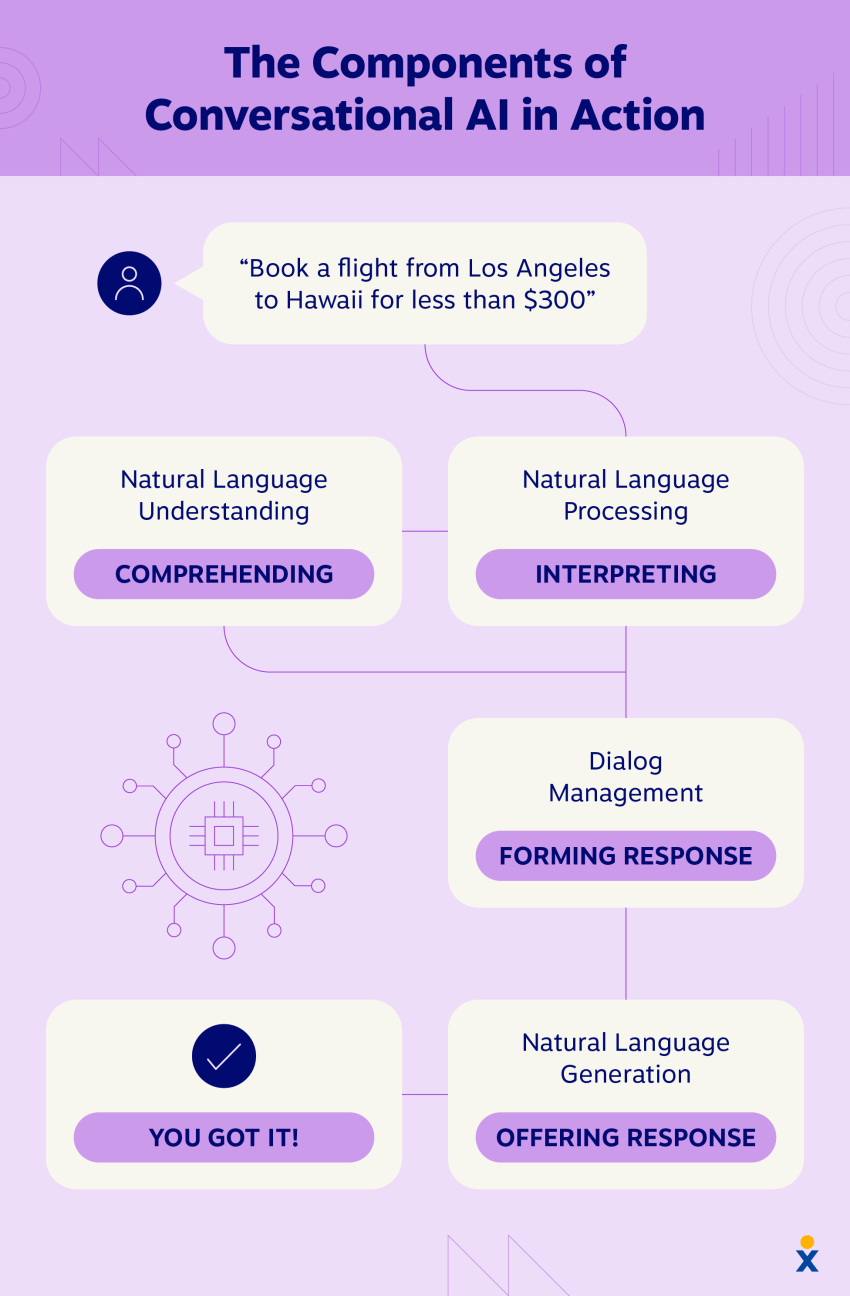
Psst! Did you know you can reduce the time per interaction by up to 50% with Nextiva’s AI-powered voice and chatbot?
Workforce management
Wish you had a crystal ball to predict peak call times and strategically schedule your customer service squad accordingly?
Workforce management tools use real-time data analytics and AI-driven forecasting to optimize staffing levels based on call volume and channel usage. They ensure you have the perfect number of agents to meet customer demand.
Optimizing agent schedules and workloads prevents long wait times for customers. These tools also keep your team happy and productive by reducing the risk of burnout and ensuring they’re energized and ready to deliver exceptional service.
Real-time speech analytics
Imagine having a real-time translator to decipher customer communications. That’s real-time speech analytics in a nutshell. It detects specific keywords, customer sentiments, pain points, and churn risk.
Grabbing these hidden insights within customer conversations can help your team identify emerging patterns or trends, discover potential issues before they go viral, and find areas for product or service improvement. It can even prompt agents to respond more effectively by offering suggested answers and solutions.
This proactive approach to stellar service and support requires no decoder ring, yet it still feels like a superpower.

Related: Customer Service Call Centers: Top Features & Best Practices
Estimated Costs When Choosing a Customer Service Contact Center
Several factors like provider and subscription models, contract length, included features, and deployment type (cloud vs. on-premise) impact contact center pricing.
When estimating costs, you’ll need to budget for:
- The communication platform (roughly $130 to $200+ per user/month)
- Voice channels (average ~$1.10 per minute)
- SMS/MMS channels (about $0.01 to $0.03 per message)
- Social media channels ($10 to $50/month)
- Data storage (varies from $1,350 to $2,100+ per agent/year)
- Data transfer/egress (about $0.08 per gigabyte after the first 100 gigabytes)
Then, you’ll need to factor in costs for advanced features (AI tools, workforce management, and custom integrations), staffing and training, business continuity measures, and other expenses.
Contact center as a service pricing models typically include two choices:
- Tiered pricing: Different pricing tiers exist based on the number of included features, inbound/outbound calls or messages, and your number of agents. Subscriptions are charged annually or monthly.
- Pay-as-you-go pricing: Pay-per-use models, where you only pay for the calls handled or features and minutes you use, offer more scalability. They ensure you only pay for the seats you need and prevent over-provisioning.
Search for an omnichannel contact center that combines multiple channels into a single platform — like Nextiva’s! You’ll get access to everything you need in your tech stack without juggling multiple licenses and vendors.
What to Look for When Tracking Contact Center Performance
Your software should track these customer service metrics to help you gauge performance and determine the ROI of your chosen platform.
Customer satisfaction
CSAT measures how satisfied customers are with the service or support they’ve received. Phone support and live chat typically have the best CSAT ratings.
Send surveys and feedback forms to gather direct responses, track sentiments, and identify areas for improvement across your CSAT channels.

First contact resolution
This metric measures the percentage of customer inquiries resolved during the initial contact. According to industry standards, first contact resolution (FCR) is 78% for retail, 71% for call centers, and 65% for tech support.
A high FCR shows that your agents are effectively problem-solving and efficiently resolving customer issues on the first try. However, it’s also important to consider the complexity of the inquiries being handled (which may explain why the tech support FCR is much lower than for retail). As long as you’re monitoring this metric, you can improve it.
Average handle time
Average handle time (AHT) measures the average time it takes an agent to resolve a customer inquiry. The industry average is slightly over six minutes.
Though your team should strive for low AHTs, fast customer service shouldn’t come at the expense of quality. Monitoring average call duration can help your team identify areas for improvement and brainstorm ways to streamline processes (hint: AI and automation are key).
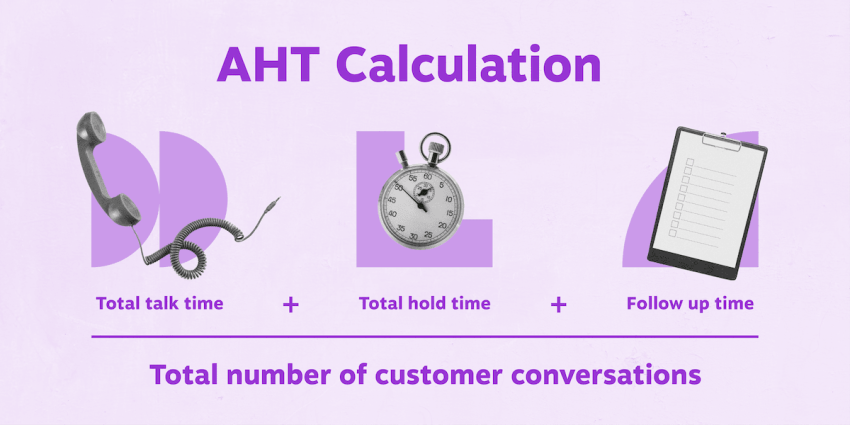
After call work
After call work (ACW) measures the time agents spend on tasks after completing a customer interaction, including updating records, adding documentation, or other less productive chores.
Minimizing ACW improves agent efficiency, ensures agents are available to handle new inquiries promptly, and allows them to spend more time helping customers (or assisting additional customers).
Look for streamlined workflows and automation tools to slash your team’s ACW. After all, happy, less bogged-down agents lead to more satisfied customers.
Agent performance
Agent performance is one of the most vital call center metrics to measure, monitor, and improve.
Keep an eye on individual metrics alongside overall team performance, especially:
- Call volume
- Agent utilization rate
- Resolution rate
- Average speed of answer
- AHT
- CSAT
These will help you identify top performers and areas where agents excel. You’ll also quickly see who needs additional training to get up to speed. Regular coaching and development opportunities allow agents to improve their performance and elevate the entire team. So, use these metrics to empower your agents, not micromanage them.
High-Performance Customer Service Teams Scale Faster With Nextiva
Launching a customer service contact center doesn’t have to be intimidating. Now that you know the must-have features to prioritize and the necessary advanced tools required to empower agents and satisfy customers, you can deliver unrivaled customer experiences.
Elevate your customer service with Nextiva, the advanced, top-ranked, AI-powered omnichannel contact center solution.
It unites fragmented customer communication with continuity across voice, email, SMS, chat, video, and social media. Our flexible, ultra-scalable contact center solution saves time and money, reduces agent and supervisor stress, and easily adapts to fit your needs.

The top-ranked AI-powered contact center.
See all the next-gen features your brand gets when you pick the number-one-rated contact center solution!

















 Customer Experience
Customer Experience 

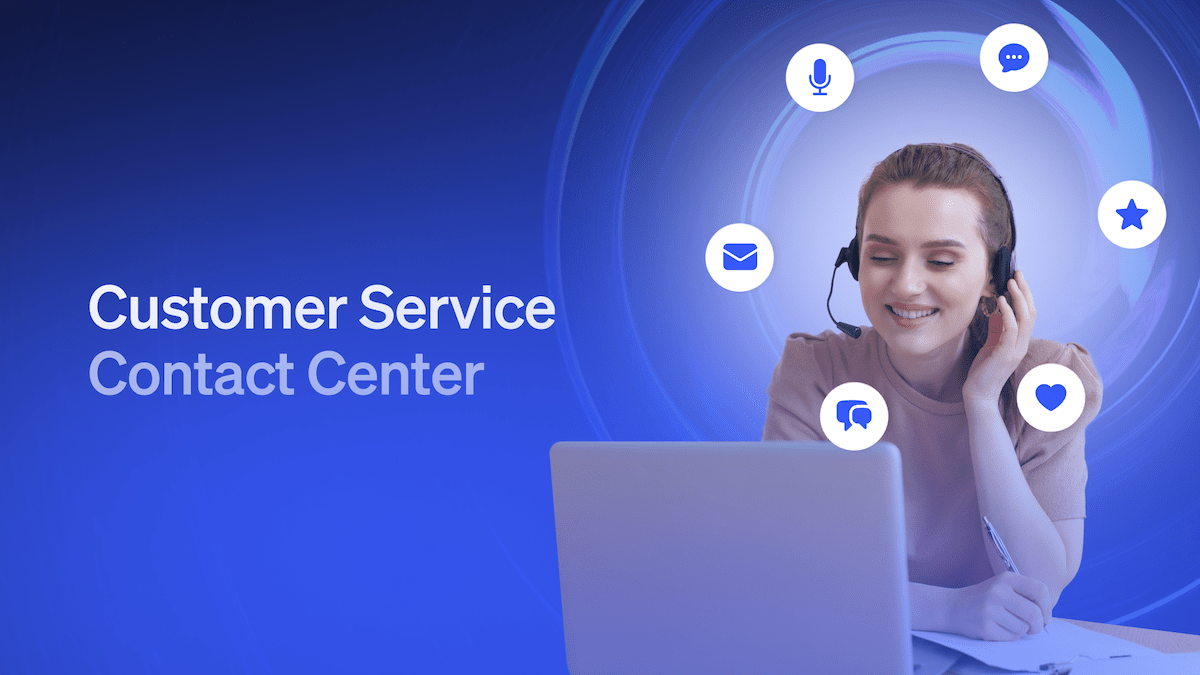
![What Is Omnichannel Customer Service? [+ Benefits & Best Practices]](https://www.nextiva.com/cdn-cgi/image/width=850,height=478,fit=cover,gravity=auto,format=auto/blog/wp-content/uploads/sites/10/2024/03/omnichannel-customer-support-hero-2-1.jpg?resize=768,432)









